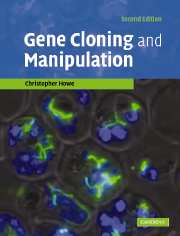Book contents
- Frontmatter
- Contents
- Preface to first edition
- Preface to second edition
- Chapter 1 The tools for the job
- Chapter 2 Polymerase chain reaction
- Chapter 3 Simple cloning
- Chapter 4 Other vector systems for E. coli
- Chapter 5 Making libraries
- Chapter 6 Screening libraries
- Chapter 7 Modification and mutagenesis
- Chapter 8 Use of cloned DNA
- Chapter 9 Using other organisms
- Chapter 10 Examples
- References
- Index
Chapter 8 - Use of cloned DNA
Published online by Cambridge University Press: 05 June 2012
- Frontmatter
- Contents
- Preface to first edition
- Preface to second edition
- Chapter 1 The tools for the job
- Chapter 2 Polymerase chain reaction
- Chapter 3 Simple cloning
- Chapter 4 Other vector systems for E. coli
- Chapter 5 Making libraries
- Chapter 6 Screening libraries
- Chapter 7 Modification and mutagenesis
- Chapter 8 Use of cloned DNA
- Chapter 9 Using other organisms
- Chapter 10 Examples
- References
- Index
Summary
Use as DNA
Cloned DNA can be used directly in too many different ways to describe here. They include sequencing, blotting (Southern, northern, southwestern, etc.), transcript mapping, footprinting and bandshift (gel retardation) assaying. Details of these can be found in general molecular and cell biology textbooks. Cloned DNA can also be used to build microarrays, as described in Chapter 1. We will concentrate first in this chapter on the use of cloned DNA sequences for expression, i.e. for directing the synthesis of RNA or protein. As we shall see, many cloning vectors have been developed specifically for this purpose. They are called expression vectors. We will then look at the use of cloned genes as tools for studying the function of other sequences.
Synthesis of RNA
Why synthesize RNA?
It may be necessary to produce RNA for a number of reasons. We might be studying RNA processing events, such as splicing or cleavage, in vitro and, therefore, need to produce RNA of a single type in the presence of as few contaminating proteins as possible. Or the aim might be to make a protein in a radiolabelled form by translation in vitro of an appropriate RNA in the presence of radioactive amino acids.
Vector systems
One approach to making RNA might be to use a vector with a powerful promoter to direct transcription in a bacterial cell in vivo and then isolate the RNA. However, because the purification of RNA from bacterial cells is difficult, and the isolation of individual RNA species even more so, the production of RNA is usually done by transcription from cloned DNA in vitro.
- Type
- Chapter
- Information
- Gene Cloning and Manipulation , pp. 162 - 181Publisher: Cambridge University PressPrint publication year: 2007



